wrestling / Columns
The Magnificent Seven: The Top 7 Randy Savage Rivalries
Randy Savage is one of the greatest professional wrestlers of all-time, presenting a near-total package as an aerial artist, a heated brawler, a mat technician, a face in peril who can sell like few others, and an awesome promo man.
After working in the Florida and Memphis territories, from the mid-1980s to the late-1990s, Savage was a top-tier fixture in the WWF and WCW, and even had a run with TNA in the early 2000s. Along the way, Savage produced outstanding matches and heated programs with a variety of opponents. Last month, he earned his well-deserved induction into the WWE Hall of Fame.
This week, I’m paying tribute to the Macho Man with a look back at his seven best rivalries.
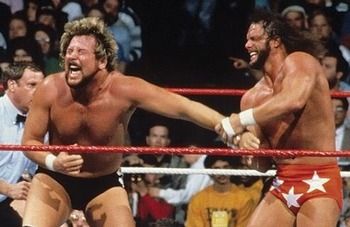
#7. Ted Dibiase
Amidst an era when Hulk Hogan was the top draw, and guys like Andre the Giant, King Kong Bundy, and The Ultimate Warrior main evented, Randy Savage and Ted Dibiase represented something fundamentally different for the WWF main event scene—a pair of smaller wrestlers with greater technical ability and stamina—not to mention that they could each hold their own on the mic.
Savage and Dibiase collided for an underrated WrestleMania main event in 1988, which saw the dawn of Savage’s first main event run on a national stage and the solidification of The Mega Powers. In the months to follow, Savage and Hogan would feud with Dibiase and Andre as The Mega Bucks, culminating in a SummerSlam showdown. The two would, tangentially, feud again in WCW a decade later, on opposite sides of the NWO war.
Savage and Dibiase spent the better part of a year atop the WWF as on-air rivals, but, ironically, they may have vied for a more important spot behind-the-scenes—the right to work as Hulk Hogan’s top heel opponent after Andre the Giant. Rumors abound that, at one time or another, Dibiase was slotted to win the WrestleMania 4 world title tournament (and probably drop the title to Savage later, for history to resume as scheduled); instead, Savage got a longer run on top, and Dibiase went down as one of the all-time greatest non-world champs.
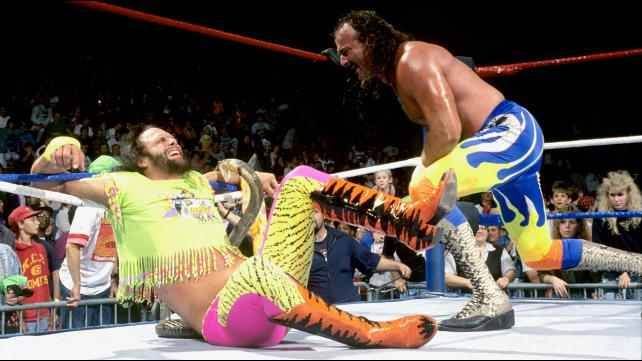
#6. Jake Roberts
By summer 1991, the experiment of pushing The Ultimate Warrior as the WWF’s top star had fallen short (made all the worse when Warrior allegedly held up Vince McMahon for money and got shown the door). Hulk Hogan was winding down his first run atop the wrestling world, and Bret Hart was still a year away from main eventing. Thus, the WWF was short on star power among top faces and Randy Savage got called from the announce table back to active duty.
In order to justify the move, the WWF needed a storyline to put Savage back in the ring (after he had dropped a Retirement Match to Warrior at WrestleMania 7). The promotion created an irresistible storyline when Savage played Miss Elizabeth’s white knight one more time, defending her against Jake Roberts’s positively vile new heel character who dared crash their wedding reception and threaten Liz with a cobra, then sic the snake on Savage’s arm in an in-ring altercation.
Savage-Roberts was hot and I’d probably rate the rivalry far higher on the countdown if it had run longer or felt more properly blown off. The two had a short match at the This Tuesday in Texas experimental PPV, brawled at the Royal Rumble, and had their last confrontation on a Saturday Night’s Main Event, but never put together a truly memorable one-on-one match. I hypothesize that they may have been bound for a WrestleMania 8 showdown, had the WWF not gotten cold feet about a Hulk Hogan-Ric Flair main event, or had to consider Hogan’s intentions to retire after the show and shuffle the card.
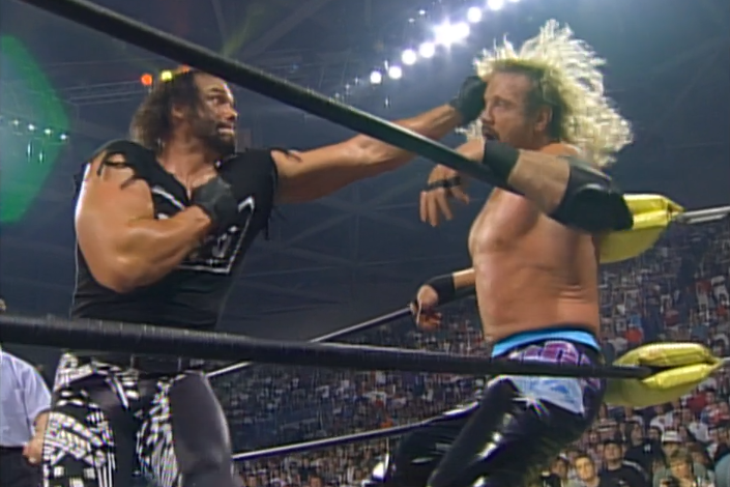
#5. Diamond Dallas Page
By the time Randy Savage debuted in WCW, he was an established top-tier star, brought in to continue at the top. He rekindled rivalries with the likes of Ric Flair and Hulk Hogan, and had his altercations with various members of The Dungeon of Doom, Lex Luger, and The Outsiders. Of everything Savage did with WCW, nothing matched the heat, in-ring product, or long-term impact as his feud with Diamond Dallas Page.
DDP was a late bloomer who started as a manager and was in his mid-thirties by the time he got in the ring. He defied the odds, though, not only becoming a singles star, but doing so amidst one of the deepest, most start-studded rosters in history, an unlikely everyman adversary to the NWO.
DDP took the next step forward in his program with Savage, a symbolic passing of the torch that saw Savage and Elizabeth antagonizing DDP and Kimberly—WCW’s closest equivalent to the Savage-Liz dynamic. After many-a-Nitro brawl, Page picked up the pinfall victory over Savage at Spring Stampede 1997 to solidify his place as a major player. The feud would continue in gimmick matches and on the opposite ends of tag teams before it culminated in a Halloween Havoc Las Vegas Sudden Death Match. Savage won that last bout, but it was Page—the worker and the character—who enjoyed the greatest rewards, as the outcome springboarded his on-again off-again program for the year to follow, opposite Hulk Hogan.
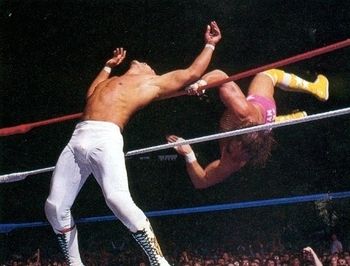
#4. Ricky Steamboat
In its early days, WrestleMania was far more sizzle than steak. Take the first two ‘Manias. Yes, they were two of the highest profile and biggest money making wrestling shows ever. Just the same, how many great matches can you name from either one of them?
The tide began to turn at WrestleMania 3.
In the build to WrestleMania 3, brash young heel Intercontinental Champion Randy Savage assaulted the ultimate whitemeat babyface, Ricky Steamboat, in an attack that culminated in him crushing The Dragon’s larynx with a ring bell. This move set up a red hot program for the two and, perhaps more importantly, set them up for what was one of the single greatest wrestling matches of all time at ‘Mania.
Savage-Steamboat had it all, from reversals and chain wrestling, to segments of wild brawling, to exchanging aerial attacks, to the sports entertainment gimmickry of George Steele getting involved. And the match ended the right way—with Steamboat getting his revenge, taking the Intercontinental Championship, and leaving with his head held high. Meanwhile, Savage had proven himself as a prime time player, and this rivalry and match set him up to move up to the very peak of the WWF in a year’s time when he would win his first world title.
And while purely WWF fans might suggest Steamboat didn’t prosper coming out of this bout (ignominiously dropping the strap to The Honky Tonk Man in the early summer), it’s worth noting that, in the grander scheme of things, Steamboat, too, was just getting rolling. In two years time, Savage would be feuding with Hulk Hogan over the WWF Championship; simultaneously, Ricy Steamboat would be trading the NWA World Championship with Ric Flair in what are pretty universally agreed to be some of wrestling’s greatest masterpieces of in-ring artistry.
Wrestling historians constantly refer to the work Bret Hart and Shawn Michaels, and The Rock and Triple H did to feud at the mid-card, and push each other to main event heights. Steamboat and Savage—though they only feuded for a matter of months and only had one truly iconic bout—just the same belong in the same conversation of hungry young talents who elevated one another into wrestling’s stratosphere.
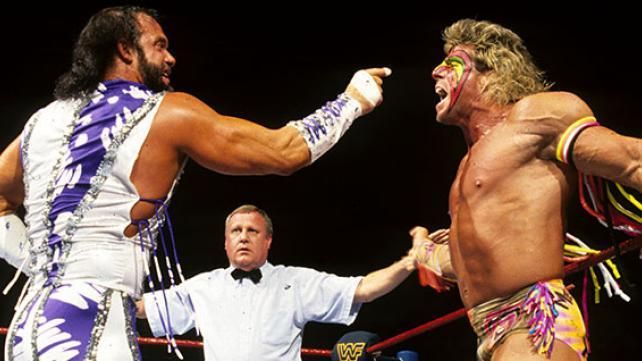
#3. The Ultimate Warrior
While Savage and Steamboat were two grandmasters when it came to in-ring performance, Savage found a different kind of sibiling star in The Ultimate Warrior—a complementary icon who rose to prominence to a shave later than the Macho Man, and who fizzled faster, but who just the same joined Savage as stars whose wattage burned just a bit shy of Hulk Hogan’s, and who became borderline household names in their era.
Savage had already graduated to the main event when The Warrior debuted in the mid-card, and by the time Warrior challenged for the world title, Savage had taken a half-step back to the upper mid-card as the Macho King. The two would clash, though, come WrestleMania 7. They built a program based on on-air professional resentment—Savage angling for a title shot and Warrior not deeming him worthy; Savage responded by interfering in Warrior’s match with Sgt. Slaughter and costing him the title. Thus, the wheels were set in motion. Hogan would face off with Slaughter for the world title and American honor. Savage and Warrior would go to war in the match to settle all scores—the loser would be forced to retire.
As a kid who was seven when WrestleMania 7 went down, Warrior-Savage came across as a positively epic clash. Add in the Savage-Elizabeth reunion in the aftermath, and you have my all-time favorite ‘Mania match and moment.
All of that would be enough for me to rank Warrior fourth or fifth in this countdown, but let’s bear in mind that the feud was revisited in the summer of 1992 after Savage had been reinstated and Warrior had returned to the promotion. The second iteration of the rivalry was face vs. face, but benefited from the intrigue of Ric Flair and Mr. Perfect claiming one of the men would turn heel and align with them (purportedly, Warrior was supposed to turn). And though the resulting match was only OK, and neither man actually turned, this second feud did offer a compelling enough first main event program of the post-Hogan era, and added boost to push Warrior to third place on this list.

#2. Ric Flair
A couple of bold, but difficult-to-deny statements: 1) The greatest match of the 1980s that lasted under 30 minutes was Ricky Steamboat vs. Randy Savage at WrestleMania 3 and 2) the three greatest matches of the 1980s that lasted over 30 minutes were all contested between Ricky Steamboat and Ric Flair.
I don’t want to take anything away from Ricky Steamboat—without question one of the greatest and most underrated workers in wrestling history. Just the same, based on the facts above, you had to expect that if Savage and Flair ever tangled they would produce some truly epic encounters.
The time finally came in 1992 when the WWF subverted expectations and casted Savage, not Hulk Hogan, as Ric Flair’s WrestleMania opponent and, as it would turn out, signature adversary of his first WWF run. The two were cast perfectly for this program—Flair as a conniving philanderer who challenged the honor and dignity of Miss Elizabeth, Savage at his best as Liz’s righteously pissed off white knight. Oh, and the WWF Championship was on the line.
Savage and Flair did put on a classic in WrestleMania 8, and then a number of lesser, but still good encounters in the months to follow, culminating in Flair winning the title back in an underrated piece of character work, in which Savage sold a bum knee like none other and ultimately passed out from the pain of the figure four. The two would rekindle their rivalry in WCW three years later, again feuding over a world title, again putting on solid matches. Much of Savage’s vengeance this time around was centered on avenging Flair’s attack on his elderly father, Angelo Poffo, but Miss Elizabeth did come into play again—this time turning on Savage and joining The Horsemen posse (because… WCW?). The two would feud tangentially in the years to follow when Savage joined the NWO.
There’s a fair argument to be made that this rivalry should be number one, and had we moved all of the matches between these two five years earlier, there’s little doubt that it would be. Savage and Flair remained elite workers into the late-mid-1990s, but you can imagine them duking out in their legit primes in the mid-to-late 1980s, with early 1990s encore? Just the same, this rivalry is worth remembering.
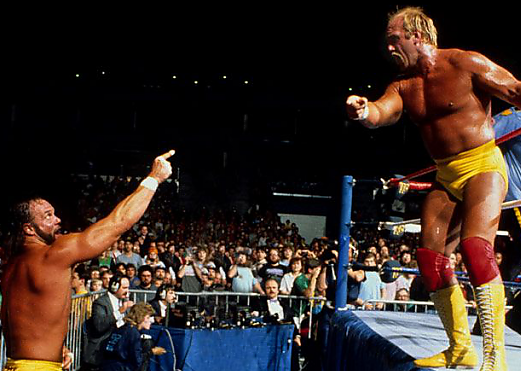
#1. Hulk Hogan
Was Hulk Hogan vs. Randy Savage compelling? Did it feature strong promo work? Was their signature match a success? Did it draw? I’d answer all of these questions with a resounding yes.
But what elevates Hogan-Savage to the number one spot on this countdown for me is how well-built and believable the whole thing was. Savage rises to the WWF Championship at WrestleMania 4, but he doesn’t really become the top guy in the company, because Hulk Hogan is still there, getting equally loud cheers and more often than not sharing the main event spotlight by tagging up with The Macho Man. Kayfabe Savage has to be conflicted. Shouldn’t he have the spotlight all to himself, just like Hogan had when he was champ? On the other hand, there are seeds of self doubt—would Savage have won the strap at all if Hogan hadn’t helped him out at ‘Mania, and could he retain it on his own against the combined resources of Ted Dibiase and Andre the Giant?
And then there’s the matter of Elizabeth. Face, heel, or tweener, the most consistent aspect of Savage’s character for the bulk of his WWF run and much of his time in WCW was that he was fiercely protective and possessive about Liz. Thus, we can assume the Macho Man would be able to come to peace with the fans seeing Hogan as his equal or superior—but could he ever really accept Elizabeth dividing her attention by managing both of them—particularly when Hogan had “lust in [his] eyes?”
Thus, the stage was set for Savage’s high profile and wildly successful heel turn as a world champ—a narrative arc clearly plotted over a year out that saw its epic climax at WrestleMania 5.
Savage and Hogan feuded in a less high profile series well before ‘Manias 4 and 5, and would continue their rivalry via tag teams and tangential situations in the years to follow their main stage feud. They’d tease another head-to-head when Savage debuted in WCW, and then realize that feud when Hogan turned heel to launch the NWO, then carried it even further after Savage had joined the NWO, then seceded to help form the Red and Black faction.
Throughout all of their ups and downs, Savage-Hogan was largely logical, and all the more believable for the way in which life imitated art. Afterall, when we talk about the biggest wrestling stars of the 1980s, it’s hard to top Hogan or Savage (I’d argue Ric Flair is the only one who really belongs in the same conversation). Hogan was the single most popular star—a true household name who crossed over to the mainstream. While the Macho Man was famous, he was never garnered quite the same level of recognition as The Hulkster despite objectively demonstrating far greater skill in the ring, and at least equal talents on the mic. Thus, Savage’s character gave voice to the underlying jealousies and resentment that could very reasonably have bubbled beneath the surface for Savage, the man.
Hogan-Savage is one of wrestling’s great rivalries. From where I’m sitting, it was the best of Savage’s career.
Which of your favorite Randy Savage rivalries did I miss? Let us know what you think in the comments section. See you in seven.
Read stories and miscellaneous criticism from Mike Chin at his website and his thoughts on a cappella music at The A Cappella Blog. Follow him on Twitter @miketchin.
More Trending Stories
- Tony Khan Weighs In On Warning From Oklahoma Athletic Commission Over Nyla Rose Match
- Backstage Update on WWE’s Plans for WrestleMania 41, Possible Move to March or May
- Jim Ross Recalls Dustin Rhodes Being Fired From WCW For Not Following No-Blood Policy
- Oklahoma Athletic Commission Gives AEW ‘Warning’ Over Nyla Rose Match, Rose Responds







